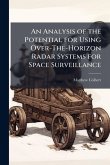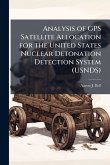In response to emerging national security threats, DoD and Intelligence Community (IC) leaders examined Space Radar's ability to meet 21st century intelligence, surveillance, and reconnaissance (ISR) requirements. They assessed the leading candidate architectures' potential performance, including a constellation of 8-14 electronically scanned array radar satellites in low earth orbit. This analysis is important for several reasons. First, it draws conclusions about potential capabilities and its utility in achieving or enhancing Joint military and National Security Intelligence mission area tasks. Understanding Space Radar's utility is important to determine if it has the potential to eliminate or reduce gaps in the C4I and ISR networks' ability to provide timely, accurate, fused, and actionable intelligence. Second, operational scenarios in the post-9/11 world increasingly require global, persistent, day and night, all-weather surveillance. Finally, bureaucratic maneuver among the military and IC regarding roles and missions keep the program from gaining enough momentum to obtain full Congressional support. In the process, Space Radar's operational value becomes increasingly misunderstood. A horizontally integrated space radar system could provide global, persistent, day/night, all-weather surveillance to fill the seams necessary to meet compressed engagement times with accurate, fused, and actionable intelligence. The unique military utility of an affordable and achievable Space Radar architecture stems from its global access, inherent flexibility, and quick responsiveness. By illuminating these key system features, this sophisticated technology can be reduced to an understandable terminology for the ongoing ISR force-mix debate. This work has been selected by scholars as being culturally important, and is part of the knowledge base of civilization as we know it. This work was reproduced from the original artifact, and remains as true to the original work as possible. Therefore, you will see the original copyright references, library stamps (as most of these works have been housed in our most important libraries around the world), and other notations in the work. This work is in the public domain in the United States of America, and possibly other nations. Within the United States, you may freely copy and distribute this work, as no entity (individual or corporate) has a copyright on the body of the work. As a reproduction of a historical artifact, this work may contain missing or blurred pages, poor pictures, errant marks, etc. Scholars believe, and we concur, that this work is important enough to be preserved, reproduced, and made generally available to the public. We appreciate your support of the preservation process, and thank you for being an important part of keeping this knowledge alive and relevant.
Bitte wählen Sie Ihr Anliegen aus.
Rechnungen
Retourenschein anfordern
Bestellstatus
Storno








